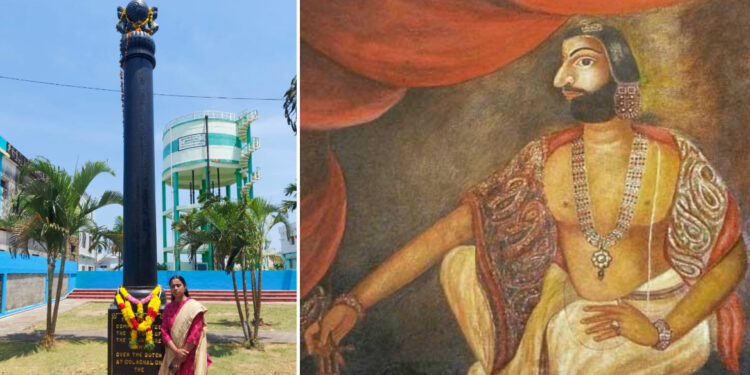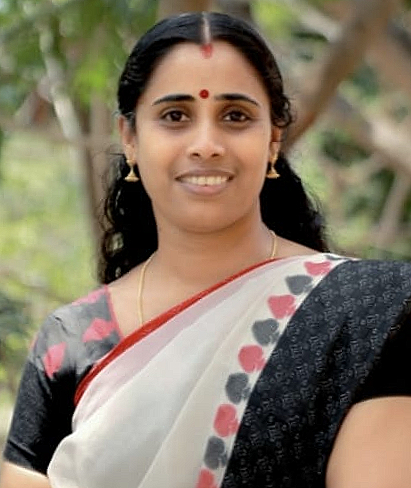On the site of Colachel War Memorial, stands a fifteen feet high granite pillar with a Valampuri or Dakshinavarti shankh (conch) on its top – the symbol of erstwhile Thiruvithamkoor samasthanam or kingdom, with the inscription “The pillar commemorates the victory of the Travancore Army over the Dutch at Colachel on 31st July 1741 A.D. 15th Karkadagam 916 M.E”. One of the walls around has conches on its top, but it opens to a water tank maintained by the Colachel Municipality and beyond that lies the Sea shore where our men fought to save the integrity of the land.
The War of Colachel, which was a major milestone in the history of Thiruvithamkoor and the Dutch-East India Company (VOC) remains in the collective memories of the citizens through numerous stories that sprung up after the massive collective victory marked by the participation of the men from all strata of the society. Everyone had their share of stories that through the years got transformed into the stature of myths.
The victory of Colachel is not a smooth sail for our army as portrayed in the popular tales. It is not a victory that became possible by deceiving the dutch army through bullock carts and palmyra trees displayed as cannons. On the other hand, this was a fierce battle fought between the Thiruvithamkoor and the Dutch, that cost many lives.
During the period, the capital of Thiruvithamkoor was located in Kalkulam, fourteen kilometres away from the Colachel port. The South Thiruvithamkoor, a major part of which forms the present Kanyakumari district, was famous for its textiles and trade. Kottar, fifteen kilometres away from Colachel was the centre of inland trade, from where pepper and clothes were transported to the Coromandel region. The Dutch East India Company (VOC) with the vain hope of establishing their supremacy over the southern coastal region of the country that stretches up to Cape Comorin or Kanyakumari from Colachel, decided to abandon their policy of not interfering in the politics of the land. A war plan was developed by Gustaaf Willem, Baron Van Imhoff in 1739, the Governor of Ceylon, through which they aimed to have a blockade of the Colachel harbour from where the import and export of the goods were carried out then. They also hoped that this would give them access to the arms and ammunition from Ceylon which was under their control then.
On 26 November 1740, Dutch launched their first attack on the town of Colachel. Dutch ships that blocked the harbour bombarded the town and several people lost their lives. The army of Thiruvithamkoor that reached Colachel paused the further advancement of the Dutch. By mid-February 1740 another fleet of ships from Cochin advanced to Colachel. But they anchored on the roadstead as the coastline was well guarded by the army of Maharaja Marthandavarma. After two weeks, Dutch managed to land on the shore which was followed by a fierce battle. Both sides lost their men. The Dutch set houses on fire and attacked the Catholic churches and priests. Five Jesuits were made captives and taken to their ships so that they could be persuaded to act against the Maharaja, to which they never obliged.
Dutch were successful in advancing towards the interior lands. The nearby Eraniel Fort and Thengapattanam, another harbour and centre of the cloth industry, second to Kottar were attacked. On March 26, Dutch bombarded Thengapattanam, destroying several houses and temples. Men, women, and children were made prisoners and sold as slaves to VOC.
On April 1, the Thiruvithamkoor army, composed of three hundred Maravar Cavalry led by Kumara Thevar, son of Ponnam Pandia Thevar, the chief of Maravar troops and Nair troops retaliated. They were led by the second prince Rama Varma. Dutch were forced to withdraw their field artillery and had to confine themselves to the fort they managed to construct.
All this while, Maharaja Marthanda Varma was gathering arms and ammunition to besiege Colachel. On 27 May, after visiting Shri Adi Kesava Swamy Temple in Thiruvattar, Maharaja Marthanda Varma marched towards Colachel with artillery and carriages, and a massive attack was launched on 6 June. By mid-June, the army of Thiruvithamkoor surrounded the fortress of the Dutch from all sides. The Dutch army from Tuticorin landed in Kanyakumari hoping to march towards Colachel via road. In the days that followed, the Dutch suffered several losses. On 27 July, the Dutch army that marched towards Aramboli (the present-day Aralvaimozhi) met with a defeat. The day that followed witnessed the launching of another heavy attack by the Thiruvithamkoor army who used mines and paper rockets with burning fuses to set fire to the fortress. Commander Rijtel of the Dutch army died following severe wounds on August 2. The Dutch soldiers surrendered themselves to Maharaja Marthanda Varma and were made captives.
This war is also the record of the abundant loyalty, cooperation, and unity displayed by every section of the society towards their State. The Jesuits of the land refused to help the Dutch even after they were held as captives for days together. The headmen of the local fishing community never obliged the enemy even though they were persuaded with hundreds of rixdollars. Maharaja could build up an army of more than twenty thousand men within months with the help of karyakarars from all communities including Nairs, Ezhava, and Mukkuvars. The victory of Maharaja Marthanda Varma against the colonial European powers is therefore the victory of the common man of our nation whose love towards their motherland is unsurpassed.
Article by Savitha AR



















Discussion about this post